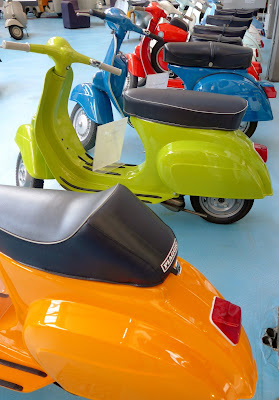Designs of the Year is an annual exhibition at The Design Museum showcasing the best of design from around the world in six categories: architecture, digital, fashion, graphics, product and transport. In each category a winner, the best of the best, is chosen by an independent jury.
We went as a family last year, 2014, which you can read here, where we had trouble agreeing on what we thought made for good design, our own judging criteria being far from independent. It's hard to agree on things when you know what you like and your mum thinks she know better. This year I went with friends, three women, three mums. What would we consider to be good design?
Firstly this.
Plant pots to live in, bringing indigenous trees back into a city in Vietnam that is only 0.25 percent green. A kind of two birds and one stone design, helping with pollution and flood prevention.
Just one problem, "you couldn't seriously sit on that wall. Look at the drop".
Then there was tea, "I'd like that", just heating the water you need. Could this be the gadget that really does slot into everyday life and doesn't get resigned to the back of the cupboard after the initial enthusiasm has died down and you realise you haven't the space for it.
Then it gets clever, we all love this. Not only for the innovation, a table that can charge your phone using daylight, but who doesn't love a good pun, "Current table". It all happens by photosynthesis.
Saving on family squabbles, it is able to charge two phones at the same time.
Another design we could totally go with. "Inglorious Fruits and Vegetables".
Common sense, playful design promoting misshapen fruit and veg, making it "appealing and cool".
An attempt to reduce waste. We learn that fifty-seven percent of the 300 million tonnes of fruit and veg thrown away each year, is due to its appearance. Crazy! Get with it, shoppers, it's thirty percent cheaper too.
Then there are the designs we are thankful we don't have to rely on, but can still get very excited about. "How cool is this?" Without being connected to a water supply, sewers or mains electricity it provides hygienic sanitation.
This toilet has everything covered. It's solar powered, waste water is cleaned, with chlorine produced through electrolysis, clean enough to wash your hands. Yes really. Waste material (you get my drift) is separated and collected to be converted into fertiliser and biogases. Practical, everyday design, yet its effects are huge. 1.8 million people die a year due to poor sanitation.
For some design, there's a story rather than an object on display. "The Ocean Cleanup", an "environmentally safe process" for removing the vast amount of plastic waste from our oceans. A project begun by a teenage engineering student, using the ocean currents to drive the rubbish towards floating barriers.
We're convinced, however evidence is provided of the damage plastic waste does in our seas.
Not all the designs that impress us are about providing practical solutions and meeting needs, some is purely aesthetic and playful.
These designs for new Norwegian banknotes, combine two different designers' ideas, front and back. They work well together, kind of need each other. Two different designers saying, "I did that!"
"A streetlamp that plays with your shadow"
We had fun with this, as it recorded our shadow and played it back when the next person walked underneath. What I loved about this, is that it brought people out onto the quieter less explored streets of Bristol purely to search them out and play. One of our favourite designs in the exhibition.
As I said, we were three mums visiting, we have kids. How clever is this? Sensing labour is underway, it texts the farmer an hour before the calf is due. A design for animal welfare, but there are parallels.
Designs of the Year 2015 is on at the Design Museum until 31 march 2016.
This is our selection, there are many more design nominations, the best of 2015. Is this the stuff of future museums? As the Design Museums says,
"Someday the other museums will be showing this stuff".
































































